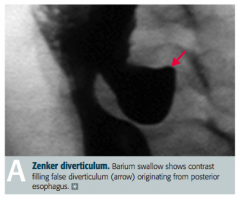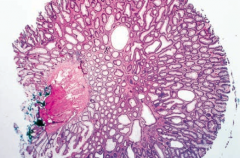![]()
![]()
![]()
Use LEFT and RIGHT arrow keys to navigate between flashcards;
Use UP and DOWN arrow keys to flip the card;
H to show hint;
A reads text to speech;
59 Cards in this Set
- Front
- Back
|
What diagnosis should you consider in an elderly male presenting with dysphagia, obstruction, and foul breath? |
Zenker Diverticulum
|
|
|
What is the name of the pharyngoesophageal false diverticulum (only through mucosa and submucosa)?
|

Zenker Diverticulum
|
|
|
What is a Zenker Diverticulum? Location?
|
- False diverticulum
- Pharyngoesophageal - Herniation of mucosal tissue at Killian triangle between thyropharyngeal and cricopharyngeal parts of inferior pharyngeal constrictor |
|
|
What symptoms does a patient with a Zenker Diverticulum show? Who is most likely to get it?
|

- Dysphagia
- Obstruction - Foul breath from trapped food particles (halitosis) - Most commonly in elderly males |
|
|
Which pathology is characterized by the five 2's: 2 inches long, 2 feet from the ileocecal valve, 2% of population, commonly presents in first 2 years of life, and may have 2 types of epithelia (gastric/pancreatic)?
|

Meckel Diverticulum
|
|
|
What is the term for the true diverticulum that forms because of the persistence of the vitelline duct?
|

Meckel Diverticulum
|
|
|
What is a Meckel Diverticulum? Cause?
|
- True diverticulum
- Persistence of vitelline duct - May contain ectopic acid-secreting gastric mucosa and/or pancreatic tissue |
|
|
What is the most common congenital anomaly of the GI tract?
|
Meckel Diverticulum
- True diverticulum - Persistence of vitelline duct - May contain ectopic acid-secreting gastric mucosa and/or pancreatic tissue |
|
|
What should you suspect in a patient <2 years old with melena (dark sticky feces containing partly digested blood) and RLQ pain?
|
Meckel Diverticulum
|
|
|
What can Meckel Diverticulum cause?
|
- Melena (dark sticky feces containing partially digested blood)
- RLQ pain - Intussusception - Volvulus - Obstruction (near terminal ileum) |
|
|
What is the term for the cystic dilation of the vitelline duct?
|
Omphalomesenteric Cyst
|
|
|
How do you diagnose Meckel Diverticulum?
|
Pertechnetate study - for uptake by ectopic gastric mucosa
|
|
|
What is the mnemonic to remember the characteristics of the Meckel Diverticulum?
|

Five 2's:
- 2 inches long - 2 feet from ileocecal valve - 2% of population (most common congenital anomaly of GI tract) - Commonly presents in first 2 years - May have 2 types of epithelia (gastric and/or pancreatic) |
|
|
Which pathology causes "currant jelly" stools?
|

Intussusception
|
|
|
What is the term for "telescoping" of 1 bowel segment into a distal segment? Most common location?
|

Intussusception - commonly at ileocecal junction
|
|
|
What are the consequences of Intussusception?
|
- Compromised blood supply → intermittent abdominal pain
- Often with currant jelly stools |
|
|
Who is more likely to get Intussusception? Associated with?
|
- Unusual in adults (associated with intraluminal mass or tumor that acts as lead point that is pulled into lumen)
- Majority of cases are in children (usually idiopathic, may be associated with recent enteric or respiratory viral infection) |
|
|
How severe is intussusception?
|
Abdominal emergency in early childhood
|
|
|
What is the term for the twisting of portions of the bowel around its mesentery?
|

Volvulus
|
|
|
What can Volvulus lead to?
|
Obstruction and infarction
|
|
|
Where can Volvulus occur? Who is more likely to get it?
|
- Midgut volvulus: more common in infants and children
- Sigmoid volvulus: more common in elderly |
|
|
What diagnosis should you consider in a newborn (<48 hours) that has bilious emesis, abdominal distention, and a failure to pass meconium? Cause?
|
Hirschsprung Disease (congenital megacolon)
- Lack of ganglion cells / enteric nervous plexuses (Auerbach and Meissner plexuses) in segment of intestine - Due to failure of neural crest cell migration - Associated with mutations in RET gene |
|
|
What genetic problem is Hirschsprung disease associated with?
|
- Mutations in RET gene
- Risk ↑ with Down Syndrome |
|
|
What are the signs / symptoms of Hirschsprung disease?
|
- Bilious emesis |
|
|
How do you diagnose Hirschsprung disease?
|
Rectal suction biopsy - confirm the lack of ganglion cells / enteric nervous plexuses in segment of intestine
|
|
|
How do you treat Hirschsprung disease?
|
Resection of aganglionic portion of colon
|
|
|
Which intestinal disorder is the most common cause of small bowel obstruction? Pathology?
|
Intestinal Adhesion:
- Fibrous band of scar tissue - Commonly after surgery - Can have well-demarcated necrotic zones |
|
|
Which intestinal disorder causes tortuous dilation of vessels leading to hematochezia? Where is it found? How is diagnosis confirmed?
|
Angiodysplasia
- Most often in cecum, terminal ileum, and ascending colon - More common in older patients - Confirmed by angiography |
|
|
Which intestinal disorder causes early bilious vomiting with a double bubble sign on x-ray? What is it associated with?
|
Duodenal atresia
- Proximal stomach distention - Failure of small bowel recanalization - Associated with Down Syndrome |
|
|
Which intestinal disorder causes hypomotility? Signs? Causes?
|
Ileus
- Hypomotility without obstruction → constipation and ↓ flatus - Distended / tympanic abdomen with ↓ bowel sounds - Associated with abdominal surgeries, opiates, hypokalemia, and sepsis |
|
|
Which intestinal disorder is associated with reduced intestinal blood flow? Location? Other?
|
Ischemic Colitis
- Pain after eating → weight loss - Commonly at splenic flexure (watershed zone) and distal colon - Typically affects elderly |
|
|
Which intestinal disorder is associated with cystic fibrosis?
|
Meconium Ileus
- Meconium plug obstructs intestine - Prevents stool passage at birth |
|
|
Which intestinal disorder is more common in preemies? Why? Location?
|
Necrotizing Enterocolitis
- Necrosis of intestinal mucosa and possible perforation - More common in preemies because they have decreased immunity - Colon is usually involved, but can involve entire GI tract |
|
|
What does an intestinal adhesion cause?
|
- Fibrous band of scar tissue, commonly after surgery
- Most common cause of small bowel obstruction - Can have well de-marcated necrotic zones |
|
|
What does angiodysplasia cause?
|
- Tortuous dilation of vessels → hematochezia
- Most often found in cecum, terminal ileum, and ascending colon - More common in older patients - Confirmed by angiography |
|
|
What does duodenal atresia cause?
|
- Causes early bilious vomiting with proximal stomach distention
- Double bubble sign on x-ray - Due to failure of small bowel recanalization - Associated with Down syndrome |
|
|
What does ileus cause?
|
- Intestinal hypomotility without obstruction → constipation and ↓ flatus
- Distended / tympanic abdomen with ↓ bowel sounds - Associated with abdominal surgeries, opiates, hypokalemia, and sepsis |
|
|
What does Ischemic Colitis cause?
|
- Reduction in intestinal blood flow causes ischemia
- Pain after eating → weight loss - Commonly occurs at splenic flexure and distal colon - Typically affects elderly |
|
|
What does Meconium Ileus cause?
|
- In cystic fibrosis, meconium plug obstructs intestine
- Prevents stool passage at birth |
|
|
What does Necrotizing Enterocolitis cause?
|
- Necrosis of intestinal mucosa and possible perforation
- Colon is usually involved, but can involve entire GI tract - In neonates, more common in preemies (↓ immunity) |
|
|
What is the term for masses that protrude into the gut lumen? Appearance?
|
Colonic polyps - sawtooth appearance
|
|
|
What are the types of colonic polyps?
|
- Adenomatous
- Hyperplastic - Juvenile - Hamartomatous |
|
|
Are colonic polyps cancerous?
|
90% are non-neoplastic
|
|
|
Where are colonic polyps usually found?
|
Rectosigmoid portion of colon
|
|
|
What are the two histologic appearances of colonic polyps?
|

- Tubular (left)
- Villous (right) |
|
|
Which type of colonic polyp is precancerous? What increases the malignant risk?
|
Adenomatous Colonic Polyps
- ↑ Size - Villous histology (more villous = more villainous) - ↑ Epithelial dysplasia |
|
|
Which type of colonic polyp is a precursor or associated with increased risk of colorectal cancer?
|
- Adenomatous = precursor to CRC
- Hamartomatous = increased risk of CRC |
|
|
What are the symptoms of adenomatous colonic polyps?
|
- Often asymptomatic
- Lower GI bleed - Partial obstruction - Secretory diarrhea (villous adenomas) |
|
|
What is the most common non-neoplastic polyp in the colon? Location?
|
Hyperplastic colonic polyps (>50% found in rectosigmoid colon)
|
|
|
Which type of colonic polyp is seen in children <5 years old? Malignant potential? Location?
|
Juvenile
- If single, no malignant potential - Juvenile polyposis syndrome: multiple juvenile polyps in GI tract, ↑ risk of adenocarcinoma - 80% in rectum |
|
|
Which type of colonic polyp is associated with increased risk of adenocarcinoma?
|
Juvenile colonic polyp in Juvenile Polyposis Syndrome (multiple polyps)
|
|
|
Which type of colonic polyp has an autosomal dominant inheritance pattern?
|
Hamartomatous:
- Peutz-Jeghers Syndrome |
|
|
What are the signs/symptoms of Peutz-Jeghers Syndrome? How is it inherited?
|
- Autosomal dominant syndrome
- Multiple non-malignant hamartomas throughout GI tract - Hyperpigmented mouth, lips, hands, and genitalia - Associated with ↑ risk of CRC and other visceral malignancies |
|
|
What are the characteristics of Adenomatous Colonic Polyps?
|
- Adenomatous polyps are PRE-CANCEROUS
- Malignant risk associated with ↑ size, villous histology, and ↑ epithelial dysplasia - Precursor to colorectal cancer (CRC) - Polyp symptoms: asymptomatic, lower GI bleed, partial obstruction, or secretory diarrhea |
|
|
What are the characteristics of Hyperplastic Colonic Polyps?
|
- Most common non-neoplastic polyp in colon
- >50% found in rectosigmoid colon |
|
|
What are the characteristics of Juvenile Colonic Polyps?
|
- Mostly sporadic lesions in children <5 years old
- 80% in rectum - If single, no malignant potential - Juvenile Polyposis Syndrome: multiple juvenile polyps in GI tract, ↑ risk of adenocarcinoma |
|
|
What are the characteristics of Hamartomatous Colonic Polyps?
|
Peutz Jeghers Syndrome
- Autosomal dominant - Multiple non-malignant hamartomas throughout GI tract - Hyperpigmented mouth, lips, hands, genitalia - Associated with ↑ risk of CRC and other visceral malignancies |
|

What does this histology show?
|

Tubular Adenoma
- Smaller, more rounded villi - More likely to be benign colonic polyp |
|

What does this histology show?
|

Villous Adenoma |

